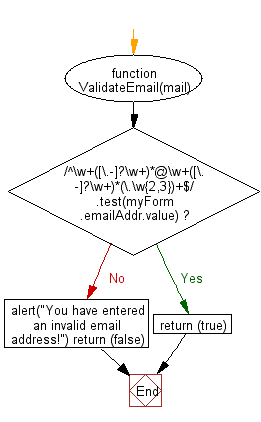JavaScript: HTML Form - email validation
- Validating email is a very important point while validating an HTML form. In this page we have discussed how to validate an email using JavaScript :
An email is a string (a subset of ASCII characters) separated into two parts by @ symbol. a "personal_info" and a domain, that is personal_info@domain. The length of the personal_info part may be up to 64 characters long and domain name may be up to 253 characters.
The personal_info part contains the following ASCII characters.
- Uppercase (A-Z) and lowercase (a-z) English letters.
- Digits (0-9).
- Characters ! # $ % & ' * + - / = ? ^ _ ` { | } ~
- Character . ( period, dot or fullstop) provided that it is not the first or last character and it will not come one after the other.
The domain name [for example com, org, net, in, us, info] part contains letters, digits, hyphens, and dots.
Example of valid email id
- mysite@ourearth.com
- my.ownsite@ourearth.org
- mysite@you.me.net
Example of invalid email id
- mysite.ourearth.com [@ is not present]
- mysite@.com.my [ tld (Top Level domain) can not start with dot "." ]
- @you.me.net [ No character before @ ]
- mysite123@gmail.b [ ".b" is not a valid tld ]
- mysite@.org.org [ tld can not start with dot "." ]
- .mysite@mysite.org [ an email should not be start with "." ]
- mysite()*@gmail.com [ here the regular expression only allows character, digit, underscore, and dash ]
- mysite..1234@yahoo.com [double dots are not allowed]
JavaScript code to validate an email id
To get a valid email id we use a regular expression /^[a-zA-Z0-9.!#$%&'*+/=?^_`{|}~-]+@[a-zA-Z0-9-]+(?:\.[a-zA-Z0-9-]+)*$/. According to http://tools.ietf.org/html/rfc3696#page-5 ! # $ % & ‘ * + – / = ? ^ ` . { | } ~ characters are legal in the local part of an e-mail address but in the above regular expression those characters are filtered out. You can modify or rewrite the said regular expression.
Flowchart :

Regular Expression Pattern
/^\w+([\.-]?\w+)*@\w+([\.-]?\w+)*(\.\w{2,3})+$/
Let apply the above JavaScript function in an HTML form.
HTML Code
JavaScript Code
CSS Code
View the Javascript email validation in the browser
RFC 2822 standard email validation
Regular Expression Pattern (Ref: https://bit.ly/33cv2vn):
/(?:[a-z0-9!#$%&'*+/=?^_`{|}~-]+(?:\.[a-z0-9!#$%&'*+/=?^_`{|}~-]+)*|"(?:[\x01-\x08\x0b\x0c\x0e-\x1f\x21\x23-\x5b\x5d-\x7f]|
\\[\x01-\x09\x0b\x0c\x0e-\x7f])*")@(?:(?:[a-z0-9](?:[a-z0-9-]*[a-z0-9])?\.)+[a-z0-9](?:[a-z0-9-]*[a-z0-9])?|
\[(?:(?:25[0-5]|2[0-4][0-9]|[01]?[0-9][0-9]?)\.){3}(?:25[0-5]|2[0-4][0-9]|[01]?[0-9][0-9]?|[a-z0-9-]*[a-z0-9]:
(?:[\x01-\x08\x0b\x0c\x0e-\x1f\x21-\x5a\x53-\x7f]|\\[\x01-\x09\x0b\x0c\x0e-\x7f])+)\])/
View the Javascript email validation (RFC 2822) in the browser
You can use the following email addresses to test the said Regular Expression:
List of Valid Email Addresses
- email@example.com
- firstname.lastname@example.com
- email@subdomain.example.com
- firstname+lastname@example.com
- email@123.123.123.123
- email@[123.123.123.123]
- "email"@example.com
- 1234567890@example.com
- email@example-one.com
- _______@example.com
- email@example.name
- email@example.museum
- email@example.co.jp
- firstname-lastname@example.com
List of Strange Valid Email Addresses
- much.”more\ unusual”@example.com
- very.unusual.”@”.unusual.com@example.com
- very.”(),:;<>[]”.VERY.”very@\\ "very”.unusual@strange.example.com
.jpg)
Comments
Post a Comment